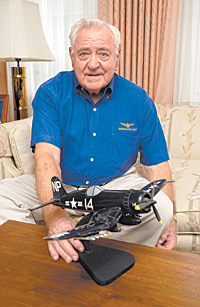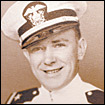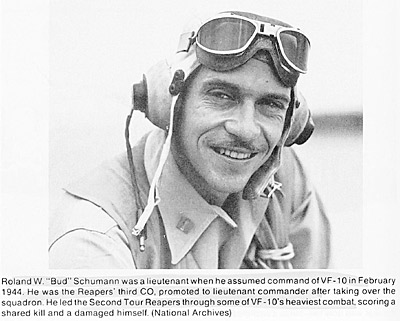Create Post
Results 1 to 3 of 3
Thread: An ace in his heart
-
09-20-04, 09:38 AM #1
 An ace in his heart
An ace in his heart
An ace in his heart
By BILL BURKE, The Virginian-Pilot
© September 20, 2004
VIRGINIA BEACH — For 60 of his 83 years, John R. Kincaid was secure in his conviction that he was a World War II fighter ace, a member of the most exalted brotherhood of American military heroes.
But the record book says otherwise, Kincaid learned recently. The American Fighter Aces Association says he doesn’t qualify for membership.
The organization is the keeper of the flame for men who achieved ace status by downing five or more enemy aircraft in mortal, swashbuckling combat – mythic figures like Chuck Yeager, Eddie Rickenbacker and Pappy Boyington. The association’s historian says Kincaid had three kills, not the five required to be dubbed an ace.
Now, Kincaid, a retired Navy captain in Virginia Beach, hopes to set the record straight, six decades after the fact.
He offers this evidence: a box full of wartime medals; a weathered flight log that bears testament to four aerial kills – one shy of ace status -– each marked by a Japanese Rising Sun flag stamped in red ink; and a memory, still rich in detail, that tells him one more flag belongs there.
That kill was taken from him 60 years ago, he insists, by commanders who wanted to spread the glory around. So fellow pilot Pete Shonk got credit for one of his aerial shootdowns on Feb. 16, 1944, Kincaid said.
He remembers the day operations officer Marion O. “Easy” Marks pulled out a rubber stamp he kept under lock and key, rolled it in a red ink pad, and pressed one, not two, flag emblems in Kincaid’s tan leather log book.
“I asked Easy Marks if I could write in my flight log, 'The skipper stole my kill,’ but he told me I couldn’t do that,” Kincaid said during a recent interview. Instead, he wrote the number 2 next to the flag, circling it in red.
If Kincaid cannot successfully argue his case, he said he will still be an ace in his heart – without portfolio.
If he succeeds, he could be the last man inducted into the brotherhood of American aces.
There have been no aces since Vietnam, and there may never be another one, military experts say, due to radical changes in the nature of aerial warfare since the heyday of air-to-air combat in World War II.
No longer do pilots engage one another at close range, ducking in and out of the clouds, machine guns chattering over the drone of propellers, as in Kincaid’s day. And American air superiority is so vast that few adversaries have the skill, or the will, to engage U.S. flyers in one-on-one combat. The dogfights that produce aces happen rarely today.
So the number of American aces is at 1,445 and holding. And the number of aging vets, like Kincaid, who can bring latter-day claims of acedom from the world wars and Korea is dwindling.
An article in the September issue of Air Force magazine asks, “Is the age of the ace finally over?”
“There won’t be any more aces,” Kincaid said. “They don’t fight each other eyeball-to-eyeball any more.”
Sorting wartime fact from fiction decades after the fact can be daunting, as the current presidential campaign has demonstrated. And Kincaid’s “lost kill” occurred nearly 30 years before Sen. John F. Kerry commanded a Swift boat and President Bush wore an Air National Guard uniform.
Several of the key players in the Kincaid saga are dead, including the squadron commander, Roland W. “Bud” Schumann Jr., and his intelligence officer, George W. Bradham – the men Kincaid says “stole” his kill. Marks, who wielded the stamp, and Jay Shinneman, one of the pilots who flew with Kincaid that day, also are dead.
Shonk, now 86 and living in Dublin, N.H., cannot confirm or deny that he was given credit for one of Kincaid’s aerial victories.
“I honestly don’t remember,” said Shonk. “It was a hell of a long time ago.”
Shonk, credited with two kills during his flying career, said he lost his flight log years ago.
Kincaid’s most persuasive supporter may be Donald “Flash” Gordon, who achieved ace status while flying two tours with the same Navy squadron Kincaid served in, VF-10.
“I sort of remember the Pete Shonk swap, but it was so long ago,” Gordon said in an e-mail from his home in California last week. “I know all about the C.O. giving other pilots credit,” he wrote.
Gordon described one busy combat mission he flew in January 1943.
“When I got to the ready room, I was asked what I did. I said that I shot down two Bettys,” the code name for Japanese bombers. But instead of getting credit for the two kills, he was instead awarded two assists, “which is like kissing your sister,” he said.
“For what it is worth I always thought John Kincaid had five kills,” Gordon said.
But the man Kincaid must convince is Frank Olynyk, official historian for the aces association. Olynyk credits Kincaid with only three kills.
Olynyk, an Ohio academican, is the final word on the authenticity of aces, said military historians Barrett Tillman and Peter B. Mersky.
Since Olynyk began his voluminous research into the history of America’s aces more than 20 years ago, few “new” aces have successfully argued their cases, Tillman said. For Kincaid and anyone else making a latter-day claim, “Frank is a tough sell.”
“If a guy is not listed as an ace by Frank, I’m suspicious of his claim,” Tillman said.
No one has been inducted into the brotherhood of the aces since October 2000, when Alden P. Rigby of Bountiful, Utah, was belatedly recognized for five kills during World War II, according to an association official.
Olynyk, in a series of e-mails, said there would be several ways to validate a claim like Kincaid’s. In addition to the flag symbols in flight logs, he would look for citations pilots received with their air medals and copies of squadron mission reports prepared at the end of a cruise that often listed flyers’ aerial scores.
Ultimately, the aces association’s Victory Confirmation Board would have to pass judgment on Kincaid’s case. It is unusual but not unheard of for an ace to receive that designation many years after the fact, said Col. Steve Pisanos of San Diego, chairman of the confirmation board.
“We would need very strong and compelling proof of the claim,” Pisanos said. “But it’s possible the Navy people may have missed this guy.”
Mersky said Rudolph Augarten was belatedly inducted as an ace a few years ago after shooting down two enemy aircraft during World War II and four while flying for the Israeli Air Force in 1948. But such a case is rare, and others have been denied admission when their numbers came up short.
Of Kincaid, Mersky said, “It’s possible he’s a forgotten ace. I’ve seen guys with 4, 4.5 kills, but they’re not aces. When you miss being an ace by one point, that’s a terrible thing.”

John R. Kincaid says the discrepancy between his record of kills and the official number can be attributed to a skipper’s policy to share the glory during the Pacific campaign of World War II. CHARLIE MEADS/THE VIRGINIAN-PILOT

A photo of John Kincaid during his Navy fighter days during World War II.

Donald “Flash” Gordon, shown getting out of an F-6F “Hellcat” fighter, supports John R. Kincaid’s story about a policy of sharing credit for kills. Photo courTesy of PEter B. MERSKY.
continued.........
-
09-20-04, 09:39 AM #2
Kincaid’s long-held belief that he is a certified fighter ace came into question after The Beacon, a Virginia Beach community news supplement to The Virginian-Pilot, published a story Aug. 8 describing him as one of a handful of surviving World War II aces.
A reader questioned the claim, which Kincaid said was verified by the National Museum of Naval Aviation in Pensacola, Fla. The museum lists him as an ace but only credits him with 3.5 kills, not enough for ace status. Museum officials could not explain the discrepancy.
Kincaid also referred a reporter to a Web site that lists him as an ace, with five kills. But while several sites place him in the ranks of aces, others, including one operated by the Navy Department, do not.
The aces association, begun in the 1960s and headquartered in Seattle, is considered by most experts to be the most credible authority on fighter aces, who are not counted by the service branches.
By his own accounting, Kincaid is an ace with room to spare. He claims seven “confirmed” and other “probable” kills, although he admits there is no way to document the latter. He made the claims in a lengthy memoir of his tour of the Pacific in 1944 that he sent to The Pilot. That account resulted in the Beacon story.
He claims to have downed three Japanese planes on Feb. 16, 1944, among them the one he said was credited to Shonk. Of that deadly encounter, he wrote:
“The Zero pressed his attack on me and opened fire – he missed. I took my lead and fired a short burst. I got a grapefruit sized ball of fire on the port engine nacelle that flashed the engine. He went down a flaming inferno. Number one was easy! I was to see many such fires in the future.
“I turned back and my section leader had a Zero on his tail – I gave the Zero a short burst and he blew – powdered, literally.
“The next Zero was coming at me from directly overhead – I went straight up – we both opened fire and I thought – this is just like the movies: all guns belching fire. The enemy Zero broke up in chunks – falling on and around me as I fell off in a hammerhead stall.”
He goes on to describe an intense dogfight in which he took on nine Zeroes, several of which may have been shot down, others sent into retreat.
“Only God and the Japanese know for certain how many of their planes never returned.,” he wrote. “Some were shot down in flames, others downed trailing smoke, others downed out of control. As for myself, I survived an onslaught of determined Japanese fighters – alone, except for the presence of Deity. It was the ending of a perfect first day of aerial combat! Conceited – no! Elated – probably! But nevertheless – an opinion founded on fact.”
Such florid remembrances, unsupported by hard evidence, would do little to impress Olynyk, guardian of the gate to official acedom.
If Kincaid can make a convincing case, he would join a pantheon of picaresque heroes who still loom over the landscape of military history: aces like Roland Garros, a French pilot believed to be the first ace, and for whom the stadium that is home to the French Open tennis tournament is named; Eddie Rickenbacker, America’s “ace of aces” with 26 kills in World War I; Manfred von Richthofen, Germany’s notorious “Red Baron,” who racked up 80 kills before perishing in the skies over France at age 25; and Col. Gregory “Pappy” Boyington, the most prolific U.S. Marine Corps ace of World War II, whose memoir “Baa Baa Black Sheep” inspired a 1970s TV series.
During a recent interview at his home, Kincaid displayed his flight log and several medals he said help validate his claim, among them a Distinguished Flying Cross with one star and an air medal with two stars he earned during the 1944 campaign.
“I’ll let the Department of the Navy give me a polygraph test, if that’s what they want,” he said.
“No matter what anybody else says, there’s no doubt in my mind I’m an ace.”
Reach Bill Burke at 446-2589 or bill.burke@piloton line.com.

Roland W. “Bud” Schumann Jr. was one of the officers John R. Kincaid blames for “stealing” some of his wartime kills. national archives.
http://home.hamptonroads.com/stories...5787&ran=93098
Ellie
-
09-20-04, 01:00 PM #3
Hello All, any WWII Marines that landed on Okinawa April 1st 1945 ever stop in here?
Thread Information
Users Browsing this Thread
There are currently 1 users browsing this thread. (0 members and 1 guests)



 Quote
Quote
Ghost Of Iwo Jima
04-04-24, 11:35 PM in Open Squad Bay